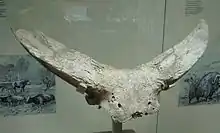Bubalus murrensis
Bubalus murrensis, the European water buffalo, is an extinct bovine that lived in Europe during the Pleistocene. Its closest living relatives are the wild water buffalo (Bubalus arnee), the tamaraw (Bubalus mindorensis), the lowland anoa (Bubalus depressicornis), the mountain anoa (Bubalus quarlesi) and the domestic water buffalo (Bubalus bubalis).[1]
| Bubalus murrensis | |
|---|---|
 | |
| Scientific classification | |
| Kingdom: | Animalia |
| Phylum: | Chordata |
| Class: | Mammalia |
| Order: | Artiodactyla |
| Family: | Bovidae |
| Subfamily: | Bovinae |
| Genus: | Bubalus |
| Species: | †B. murrensis |
| Binomial name | |
| †Bubalus murrensis Berckhemer 1927 | |
Description
The morphology of Bubalus murrensis is very similar to other Bubalus species like the Wild Asian water buffalo (Bubalus arnee). Only the skull differs from other bovines, especially the triangular horns. A skull found in Rhineland-Palatinate (Germany) had a width of 107 cm.[2]
Distribution and habitat
The European water buffalo occurred in river valleys. Remains are very rare. The majority of finds have come from along the Rhine, Elbe and Murr in Germany and the Netherlands. Isolated specimens have also been found between the Atlantic coast of France in the west and the central part of the East European Plain in the east (a superbly preserved Allerød-aged skull from Moscow Oblast, near Kolomna).[3][4] It lived in muddy and swampy terrain.[5][6] Bubalus murrensis could not tolerate long-lasting episodes of frost and was therefore absent in Central Europe during the Glacial Periods. During the Interglacial Periods like the Eemian it occurred together with other species of the Interglacial faunal assemblage, including the straight-tusked elephant (Palaeoloxodon antiquus), Merck's rhinoceros (Stephanorinus kirchbergensis), fallow deer (Dama dama), aurochs (Bos primigenius) and the European hippopotamus (Hippopotamus antiquus).[7][8][9]
References
- H. Dieter Schreiber (2004): Finds of Bubalis murrensis (Bovinae, Mammalia) from the Upper Rhine valley: a focus on the complex sedimentological conditions of a Quaternary fluviatile system, 18th International Senckenberg Conference, Weimar
- Naturhistorisches Museum Mainz/Landessammlung für Naturkunde Rheinland-Pfalz (2009): Jahresbericht des Museums und der Landessammlung 2008. Wissenschaftliche Sammlungen.. Mitteilungen der Rheinischen Naturforschenden Gesellschaft 30: 52-54. Mainz. (german)
- v. Koenigswald, Wighart; Schwermann, Achim H.; Keiter, Mark; Menger, Frank (2019). "First evidence of Pleistocene Bubalus murrensis in France and the stratigraphic occurrences of Bubalus in Europe". Quaternary International. 522: 85–93. doi:10.1016/j.quaint.2019.06.019. ISSN 1040-6182.
- Vislobokova, I. A.; Tarasenko, K. K; Lopatin, A. V. (2020). "The first discovery of european water buffalo Bubalus murrensis in the late Pleistocene of the Russian Plain". Proceedings of the Russian Academy of Sciences. Life Sciences. 491: 125-129 (in Russian).
- Wighart von Koenigswald: Exoten in der Großtierfauna des letzten Interglazials von Mitteleuropa. Eiszeitalter und Gegenwart 41, 1991, S. 70–84
- Van Dam, I. (1997). "De eerste vondst van de Europese waterbuffel, Bubalus murrensis (Berckhemer, 1927) in Nederland". Cranium. 14: 49–54.
- Pushkina, Diana (2007). "The Pleistocene easternmost distribution in Eurasia of the species associated with the Eemian Palaeoloxodon antiquus assemblage" (PDF). Mammal Review. 37 (3): 224–245. doi:10.1111/j.1365-2907.2007.00109.x.
- Kolfschoten, Th. van (May 2000). "The Eemian mammal fauna of central Europe" (PDF). Netherlands Journal of Geosciences. 79 (2/3) (2–3): 269–281. doi:10.1017/S0016774600021752.
- Baumgart, B. (1997). "Vor- und nacheiszeitliche Großtiere in Mitteleuropa und ihre Einpassung in das Ökosystem - Stand der Projektentwicklung zum Großtierschutzgebiet Teltow-Fläming". Brandenburgische Umweltberichte: 118–129.